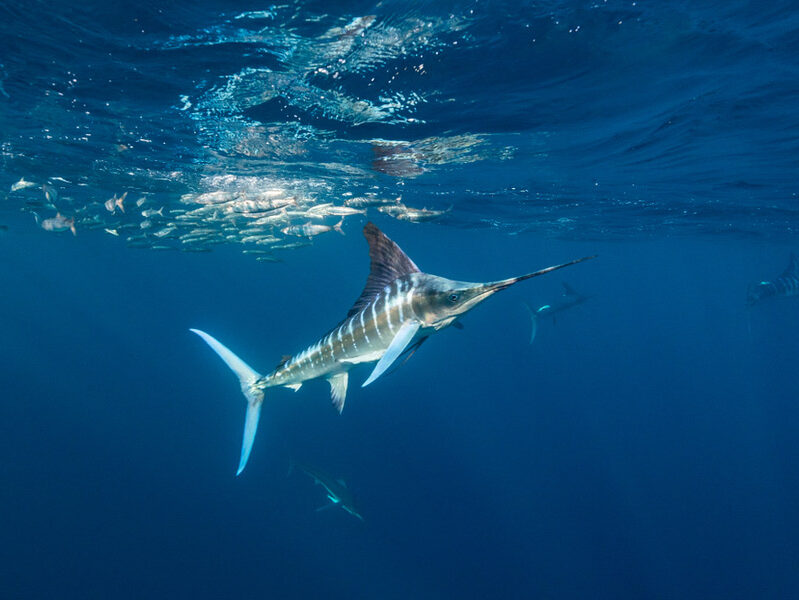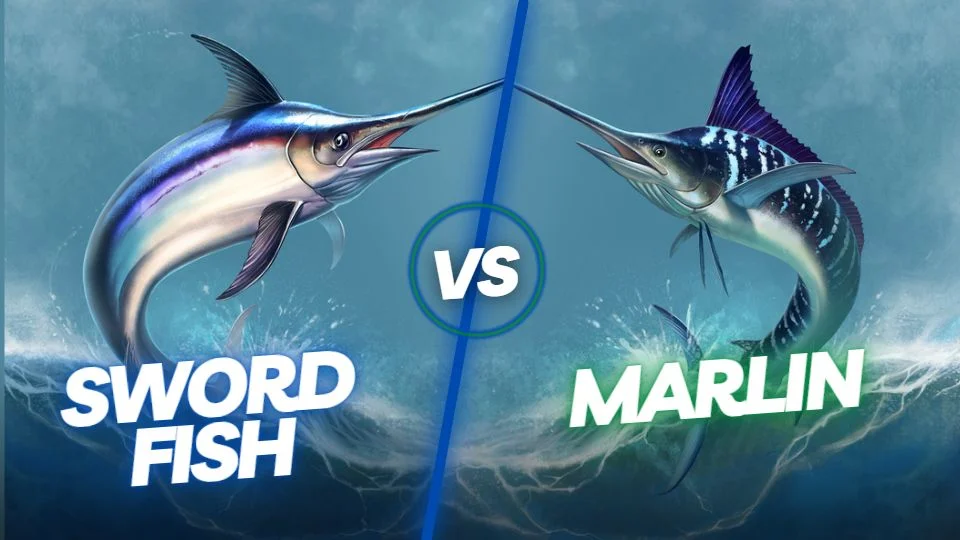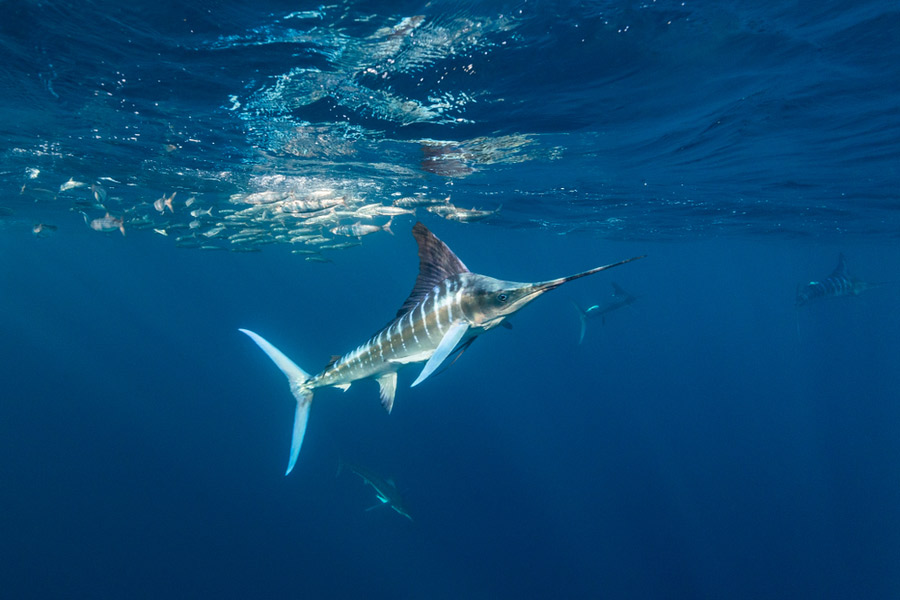What’s the REAL Difference Between Marlin VS Swordfish?
Written By: Captain Kody Michael
You can’t discuss a “marlin vs swordfish” without first exploring their similarities. Both marlin and swordfish belong to the billfish family and are highly sought-after targets for anglers around the world.
Billfish exhibit remarkable migratory patterns and are known to travel vast distances across the oceans. Some fish are even tracked throughout the Atlantic, which showcasing their incredible navigational skills.
Their impressive size and distinctive sword-like bills often lead to confusion, prompting the question, “Is a marlin a swordfish?” While they may appear similar at first glance, a closer examination reveals unique features that set them apart.
Let’s dive in!
Marlin vs Swordfish – Is a Marlin a Swordfish?
In short.. while these fish may look quite similar and have similar characteristics, they are not the same.
Beyond their family ties, the physical characteristics of marlins and swordfish highlight two distinct evolutionary paths, each finely tuned to thrive in the ocean. These differences reflect their adaptations to diverse environments and hunting strategies, making them fascinating subjects for both scientific study and fishing enthusiasts.
1. Physical Characteristics
Marlin Body Structure
- Marlins are known for their streamlined, elongated bodies, which help them reach remarkable speeds in the water. They typically display a vibrant color palette that can vary between species. For example, the blue marlin boasts deep blue hues on its back, transitioning to a silver belly, while the black marlin features dark blue or black coloring.
- Their dorsal fin is tall and pronounced, resembling a sail when raised, which is why many anglers find them visually captivating. Marlins possess long, pointed bills that are designed to slash through schools of fish, aiding in their hunting strategy.
Swordfish Body Structure
- In contrast, swordfish exhibit a more robust and stocky body shape, often described as torpedo-like. Their most striking feature is their flat, sword-like bill, which is significantly broader than that of a marlin. This distinctive bill enables swordfish to slash through schools of fish effectively, making them formidable hunters.
- Swordfish tend to be darker in color, often exhibiting a blend of brown and silver tones that provide effective camouflage in deep waters. Their smaller dorsal fin and lack of a pronounced sail-like structure differentiate them from marlins.
Marlin vs. Swordfish: Size Differences
Both marlin and swordfish can grow to impressive sizes, but marlins tend to be larger on average. Blue marlins, for instance, can weigh over 1,000 pounds and reach lengths of up to 14 feet, while swordfish typically weigh between 200 to 600 pounds, with maximum lengths of around 10 feet. This size difference plays a crucial role in their respective fishing techniques and the challenges they present to anglers.
2. Behavior and Habitat
When considering the key difference of marlin vs swordfish in terms of behavior and habitat, it’s clear that both species have unique migratory patterns. Marlin tend to shift their movements based on water temperature and prey availability, adapting to seasonal changes in their surroundings. In contrast, swordfish migrate more consistently, often diving deep to adjust to variations in light and temperature. Recognizing these differences is essential for the effective conservation and management of these remarkable species.
Migration Patterns of the Marlin
- Marlins often migrate seasonally to spawn and feed, traveling vast distances across the oceans. They can be found in both coastal and offshore environments, often near underwater structures like reefs or drop-offs.
- Their migratory behavior is influenced by water temperature and the availability of prey. Marlins are known to congregate during spawning seasons, making them more accessible to anglers.
Migration Patterns of the Swordfish
- Swordfish also migrate, but they typically prefer deeper waters, often found at depths of 200 to 1,000 feet. They are known for their nocturnal feeding habits, coming closer to the surface at night to hunt.
- Unlike marlins, swordfish are more solitary creatures and are less likely to form large groups. Their preference for open ocean environments means that they can be found in a wide range of oceanic regions, from the warm waters of the tropics to cooler temperate zones.
Behavioral Traits of the Marlin
- In terms of behavior, marlins are often more acrobatic than swordfish. When hooked, marlins are known for their spectacular leaps and fast runs, creating a thrilling experience for anglers. Their agility and speed make them challenging to catch, often resulting in high-stakes battles on the water.
Behavioral Traits of the Swordfish
- Swordfish, on the other hand, tend to exhibit different behaviors when hooked. While they can also put up a fight, they are less likely to leap out of the water. Instead, swordfish often dive deep and attempt to shake the hook, providing a different challenge for anglers. Their stealthy approach to hunting also means they rely on surprise attacks rather than high-speed pursuits.
3. Feeding Habits
The dietary preferences and hunting strategies of marlin vs swordfish really highlight their differences. Let’s dive in!
Marlin Feeding Habits
- Marlins primarily feed on smaller fish, such as mackerel, herring, and sardines, as well as squid. Their hunting style is characterized by speed and agility, using their long bills to slash through schools of prey.
- Marlins are opportunistic feeders and often hunt in packs, which increases their success rate. They rely on their keen eyesight to spot potential meals, often targeting schools of fish gathered near the surface.
Swordfish Feeding Habits
- Swordfish have a more diverse diet, feeding on a range of prey, including larger fish like tuna and even smaller billfish. Their hunting technique is different; they use their flat bills to slash at schools of fish, stunning or injuring their prey before swallowing it whole.
- Swordfish are primarily nocturnal hunters, using their excellent vision to navigate and hunt effectively in low-light conditions. This ability to hunt at night distinguishes them from marlins, who tend to be more active during the day.
4. Culinary Value
Both marlin and swordfish are popular in culinary circles, but they offer distinct flavors and textures.
Marlin
- The meat of marlin is typically lean and firm, with a slightly sweet flavor profile. It is often compared to tuna in terms of taste and texture, making it a favorite among seafood lovers.
- Marlin can be enjoyed in various culinary preparations, including grilling, smoking, and sashimi. Its versatility in the kitchen allows chefs to experiment with different cooking techniques and flavor pairings.
Swordfish
- Known for their meaty texture and rich, savory flavor, swordfish is a staple in seafood cuisine. The firm, steak-like consistency of swordfish makes it an excellent choice for grilling, broiling, or pan-searing.
- Its ability to hold up well to marinades and spices allows for a wide range of culinary applications, making it a popular choice in restaurants and home kitchens alike.
5. Conservation Status
As both marlin and swordfish are highly sought after for recreational and commercial fishing, their populations have faced pressure. Overfishing and habitat loss pose significant threats to both species, leading to varying conservation statuses across different regions. Responsible fishing practices, including catch-and-release techniques and adherence to local regulations, are essential for ensuring the sustainability of these magnificent fish.
Conclusion
While marlin vs swordfish come from the same billfish family, they each have their own unique traits. Their differences in physical characteristics, behaviors, habitats, feeding habits, and culinary uses reveal how each has adapted over time. Recognizing these distinctions not only helps us appreciate these amazing fish but also guides responsible fishing practices to protect their populations for future generations.
Whether you’re an avid angler or just a seafood lover, understanding marlin vs. swordfish can really enhance your connection to the rich world of ocean life. So next time you’re out on the water or enjoying a tasty seafood dish, you’ll have a deeper appreciation for these incredible fish!
Drop a Comment!
We’d love to hear from you! If you have any tips or experiences to share, feel free to drop a comment below. Have any questions about what you read or about fishing in general? Don’t hesitate to ask!
For more tips and techniques on fishing, don’t forget to subscribe to our blog and follow along on our fishing adventures on our channel Reel Guides TV on YouTube.
Ready to book your next Swordfish charter?
We started Reel Guides to make it easy to book fishing trips at your preferred destination!
Click here to browse and book your next swordfishing charter throughout the United States.
Use promo code REELGUIDES for an additional 20% off your next order at www.mustad-fishing.com.




